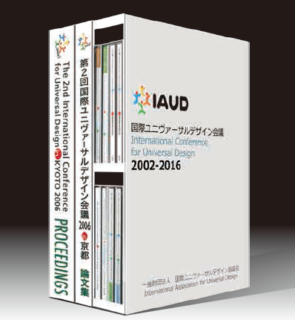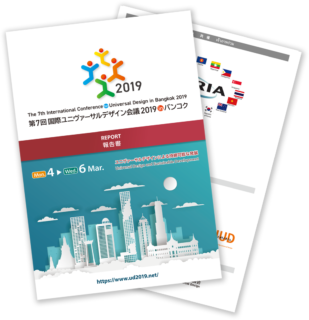2025.05.29
Day 3: October 14 (Sunday)
2012.10.20 Updated
Session 6: Development of UD in East Asia


Young-jun Ko (Professor of Design Dept., Seoul National University of Science and Technology/ Vice President, Korea Society of Science of Design: Korea)
Subject: Universal Design in Korea
Spurred on by the ongoing ageing of the population, growing numbers of overseas visitors, improvement in UD education in universities and efforts by companies to develop UD products, UD is making steady progress in South Korea. One visible indication of this progress is the presence of English as well as Hangul signage in public places. Other visible indications are the presence on almost all subway platforms in the city of Seoul of fall prevention fences, the installation of gap covers between platforms and trains, and the installation of wheelchair lifts to facilitate boarding and exiting trains.
The operation of low-floor buses has also facilitated transportation for wheelchair users, and the use of slopes on walking trails in nature parks has enhanced the freedom of movement of wheelchair users. Many companies including Samsung have also embraced universal design.
While the application of UD has become evident in South Korea, there is a need for further development. In the future we must also give more thought to UD infrastructure for dealing with natural disasters.

Hua Dong (Professor by Special Appointment, Tongji University: China / Senior Lecturer, Brunel University: UK)
Subject: Universal Design in China
Barrier-free environments were established in approximately 100 cities in China in the lead up to the 2008 Beijing Olympics. At present 1.13 million design students are studying universal design. Design to cater for an aging society is also being promoted in China.

Chan Lai Kiu (Vice Chairman of Hong Kong Architecture Centre: Hong Kong)
Subject: Universal Design in Hong Kong
Although I am not a specialist in UD, I am an architect and I have put UD into practice from the perspective of a person who views architecture as a service for people and who understands the importance of initiatives in promoting barrier-free environments. Together with my family, I have actively adopted UD in the course of our everyday lives.
Hong Kong is a city highly concentrated in a vertical direction. This environment has promoted the development of technology in lifts. On the other hand, the use of lifts poses serious risks in times of disaster. About 25% of Hong Kong's land is utilized while 75% is reserved for green areas and open spaces.
UD in public transportation is well developed. Various techniques have been devised to make effective use of narrow spaces. We will continue to develop UD to live comfortably in this environment.
The following can be cited as reasons underlying the development of UD in East Asia in recent years:
- Increases in the number of foreign visitors due to the Olympics, international expositions, and continuing internationalization
- Penetration of UD ways of thinking among the younger generation due to improvements in design education and its expansion
- Introduction of barrier-free infrastructure and the ongoing ageing of society accompanied by the development of products catering to this sector of society
UD in this region of the world is set to continue. There will be an ongoing need for various ideas to respond to earthquakes and other natural disasters and ideas for safe, secure living in congested cities
Session 7: Sustainability – Creating, Developing and Maintaining a Safe, Secure Society

A discussion on sustainability was held during this session, which welcomed specialists in various fields such as universal design, problems in ageing, and sustainability. As he presented various case studies, Dr. Arai stressed that a place where both UD users and creators could engage in discussion was needed in order to eliminate the invisible barriers between the two parties. Dr. Shiraishi then described the current status of Japan's ageing society and indicated that the richer people's interaction with society, the healthier they remained and the longer they lived. He also pointed out the importance of means of mobility. Dr. Masuda spoke about "backcasting", viewing the present with a vision of the future to realize a sustainable society. Recalling the Great East Japan Earthquake disaster, he pointed out that "all human beings are persons with disabilities at the time of a natural disaster".

Toshiharu Arai (Professor, Kanazawa College of Art: Japan)

Masaaki Shiraishi (President, Japan Productive Ageing Research Center: Japan)

Fumikazu Masuda (Design Consultant/Professor, Tokyo Zokei University: Japan)
IAUD Awards 2012 Presentation/Award Ceremony


Special Award/HIH Prince Tomohito of Mikasa Award:
Ricoh, Co. Ltd.

Ricoh Co., Ltd. is announced as the winner

Grand Award/Minister of Economy, Trade and Industry
Award: Sekisui House, Ltd.

Presentation scene of Sekisui House, Ltd.

Judging Committee Chair: Dr. Richard Coleman
Session 8: Sustainability – Safe and Secure Energy Resources
As specialists in the field of renewable energies, both professors explained how wind power and geothermal heat are used. Citing specific examples of their use during their presentations, they also made recommendations regarding issues in the use of these resources as safe, reliable sources of energy in the future.

Yuji Ohya (Professor, Research Institute for Applied Mechanics, Kyushu University: Japan)
Dr. Ohya gave specific examples of the methods for using "lens windmills," which are capable of harnessing wind power for more effective power generation. In particular, he spoke of the challenges in realizing multi-purpose offshore floating wind turbine energy farms in the future as an effective way of utilizing Japan's exclusive economic zones (EEZ), which collectively comprise the world's sixth largest EEZ in area.

Isao Matsunaga (President, Geothermal Research Society of Japan/Emeritus Researcher, National Institute of Advanced Industrial Science and Technology: Japan)
In addressing the challenges of effectively utilizing Japan's vast geothermal resources, said to be the third most abundant in the world, Dr. Matsunaga talked about the need to overcome the infrastructure costs involved and issues related to national parks. He also spoke of the need in the future to establish systems, develop technologies, and train personnel from a long-term perspective to successfully utilize these resources.
Session 9 (Closing Session): Safety and Security – A Sustainable World

In summing up the 4th international conference, coordinator Keiji Kawahara (IAUD Executive Director) called upon participants to reflect on the conference's achievements, new issues and developments that became apparent in the course of the conference, and future points for discussion.

Keiji Kawahara (Executive Director, IAUD: Japan)

Roger Coleman (Professor Emeritus, Royal College of Art: UK)
This conference clarified those areas that we should focus on in the future in promoting UD activities. It is important for us to execute UD activities from the perspective of companies, local governments, and ordinary citizens. We can change society through methods with broad applicability and people-friendly measures. It is vital that we implement activities to improve not just the lives of a few but the lives of everyone and to share our methods and measures.

Valerie Fletcher (Executive Director, Institute for Human-Centered Design: USA)
We must share examples of the ways in which Japan coped following its recent major earthquake disaster. It is wonderful that so many companies participate in UD activities in Japan. When it comes to implementing activities, it is difficult to rely on individuals alone. In the future we must also involve economists and others in our efforts. Approximately one billion people of the world's population of seven billion have disabilities. It is clear that the need for UD is not "someone else's problem." The activities of IAUD are unique and should be shared globally. To do this, we must establish a balance between academics and the general population in our initiatives.

Francesc Aragall (President, Design for All Foundation: Spain)
This conference captured the interest of people in terms of how we can pass on information and know-how as shared knowledge. Products designed for people with disabilities have become products that we all can use. The activities of universal design should be initiated from the heart rather than as simple fundamental rights. They should be conceived of in a spirit of compassion and empathy. While this may be a very Japanese way of thinking, I think it is something that we all should learn from. The collective strength of organizations is vital, and the enthusiasm of ordinary citizens will increase the strength of UD. Now is the time to put UD into practice in all areas.

Fumiyo Kojima (Chairman of the Board of Directors, IAUD: Japan)
The corporate world, national government and municipal government must join forces in promoting UD activities. It was very important for as many people as possible to participate in this conference and to understand our activities, without making the conference overly specialized. I would like to see the sharing and horizontal deployment of good examples of UD and to promote these on a global scale. However, good examples inevitably become obsolete over time, so we must devise a system for their ongoing development. We must also develop systems for continually enlisting the efforts of young people as leaders. As we develop our UD activities, I think we must always aim to establish horizontal global links and vertical generational links.
Closing Ceremony
Following on from the closing address delivered by Kazuo Okamoto, President of Organizing Committee, Dr. Valerie Fletcher announced the outstanding papers. A Global Commitment was then signed. Finally, executive committee Chair Kojima read the Declaration of UD2012, reflecting the general tenets of the conference discussions, and the three-day international conference was brought to a close.

Address by Kazuo Okamoto,
President of Organizing
Committee

Signing of the Global Commitment
UD Certification- Holding of the first official Level 1 Certification Examination

Training and examination of basic knowledge in universal design covering knowledge and competence in accurately choosing appropriate products and services.
A two-hour group training seminar was followed by a one-hour comprehension test consisting of 50 questions.
Approximately 40 people participated in the training seminar and the examination.
- Lecturers:
- Satoshi Kose (Chair, UD Certification Specialist Committee; Professor, Shizuoka University of Art and Culture)
- Yoshihiko Kawauchi (Deputy Chair, UD Certification Specialist Committee; Professor, Toyo University)
- Masayoshi Kubo (Committee Member, UD Certification Specialist Committee; Professor, Kyoto Institute of Technology)
- Qualifications for sitting the exam:
- No restrictions
- Registration of qualification;
- A "UD Level 1 Certification of Qualification" was subsequently issued to the successful candidates.

Dr. Satoshi Kose, Lecturer
Back to Day 2 << Index >> Poster Session
Inquiries
![]() Please make your inquiry here (you will be automatically transferred to the Inquiries page).
Please make your inquiry here (you will be automatically transferred to the Inquiries page).









